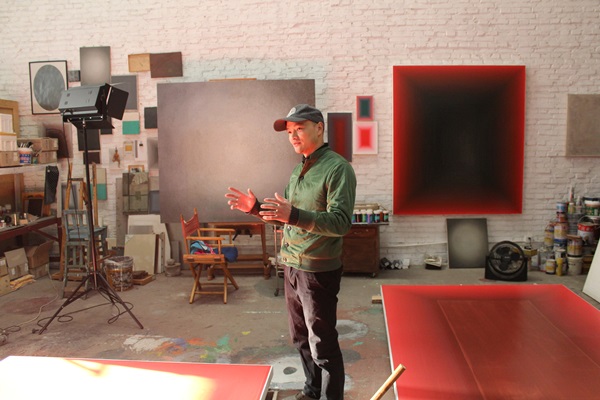
Celebrated abstractionist Wang Guangle is best known for his memento mori-type abstraction—inspired by the traditional burial practices in the Fujian Province of southern China. His tactile works are produced in a process of repetitive layering of different colors of acrylic paint. Guangle’s work is united by his interest and experiments in depth and space. He studied at the Central Academy of Fine Arts in 2000, and has been featured in many international exhibitions, including at the Museum Boijmans Van Beuningen in Rotterdam, the Zhejiang Art Museum in Hangzhou, and the Museum Ludwig in Cologne. He currently lives and works in Beijing.
When did you know you wanted to be an artist?
Even though I have been attending art schools since age 16, I didn’t seriously consider becoming an artist until I was 24 and about to graduate from university. It was a part of a much bigger, existential question of how to live and be. I pondered this for along time, because I always had problems interfacing with society—for example, even after so many years, I could not become accustomed to the rigid regulations and culture of my schools, so the idea of entering an even larger, more unfathomable general society was very terrifying to me. The abstract idea of finding a job, securing health insurance, and establishing residency in a city made me feel like I was connecting my body to a cold machine. Additionally, we can’t always have what we want, and society does not have a reliable, predictable path carved out for fine artists. I decided it would make more sense for me to learn about myself and discover a new way to relate to the world. I was drawn to beggars, the homeless, and other disenfranchised people left behind by the social machine. The freedom they embody was attractive to me, and made me feel all the jobs and other bullet points my parents wanted me to achieve are precisely what inhibits independence and autonomy, and are not required elements in life. I thought, if I could live without these preconditions, all my problems would resolve themselves. After thinking through all these considerations, I became what one would call an artist, and I now devote much of my time to what I am truly passionate about. My pursuits adjusted my relationship with society to one which I am comfortable with.
Wang Guangle, Coffin Paint 14019 (2014)
Photo courtesy of Pace Gallery.
What inspires you?
The sensation of the passage of time always inspires me. Time changes everything, and when I can detect the pure movement of time, nothing else seems to matter. In these moments, there is very little else I would want to do.
Wang Guangle, installation view (2014)
Photo courtesy of Pace Gallery.
If you could own any work of modern or contemporary art, what would it be?
I want to own a “PVC Strandbeest” by Theo Jansen.
Wang Guangle, Coffin Paint 140722 (2014)
Photo courtesy of Pace Gallery.
What are you working on at the moment?
I’m currently working on mixed concrete sculptures by hammering together discarded concrete bits I gathered at construction sites. Mixed concrete is a combination of concrete and pebbles, and the concrete parts are softer than the pebbles and easier to carve, giving the finished surface the smooth yet variegated texture of a dam that has been assaulted by the waves for decades.